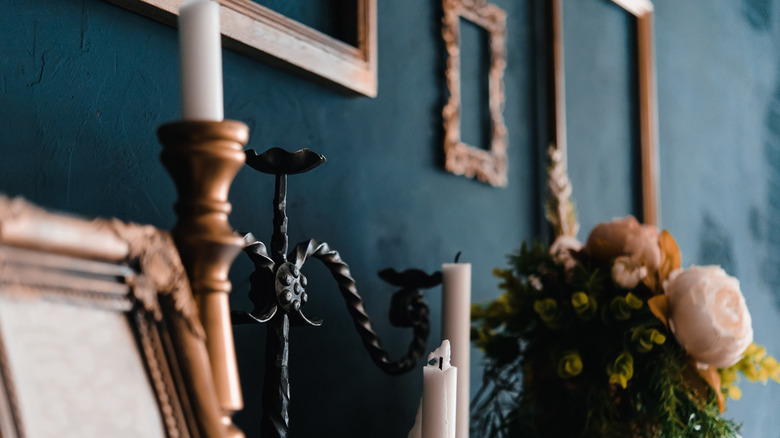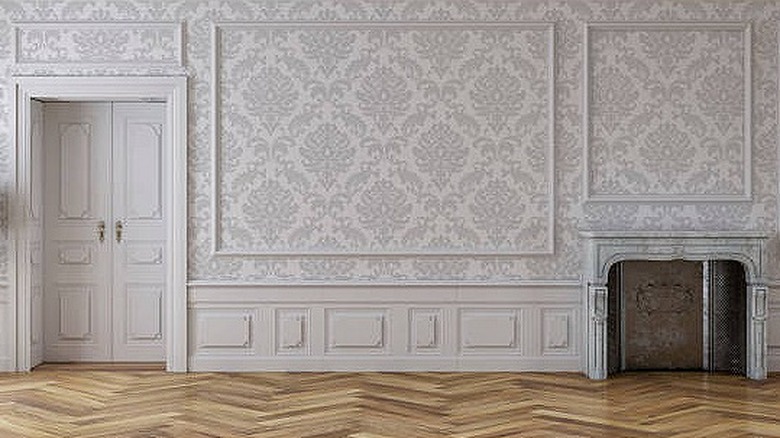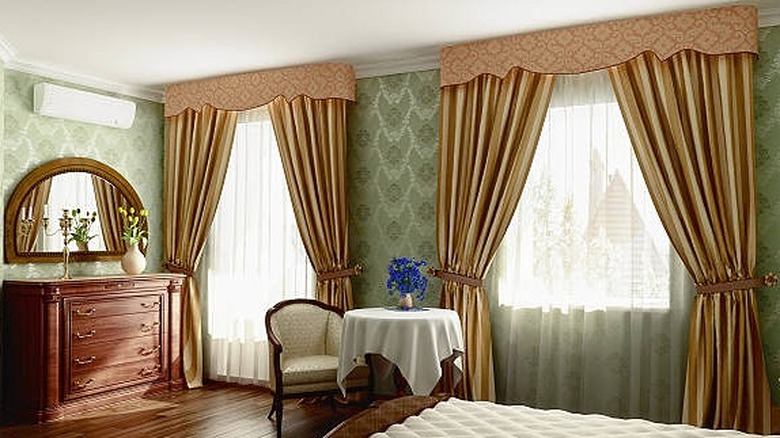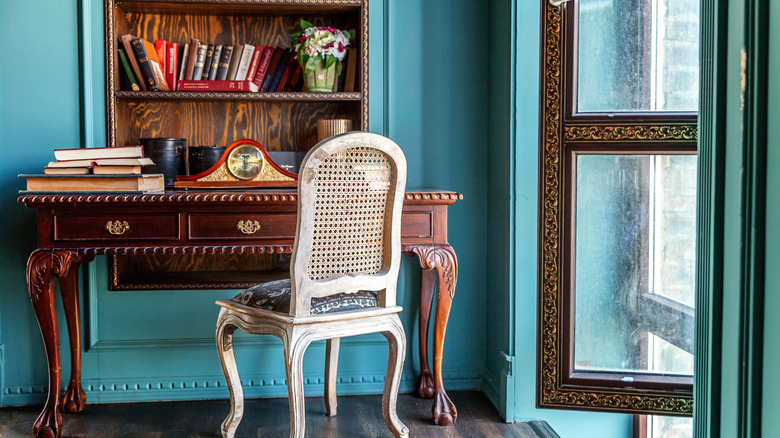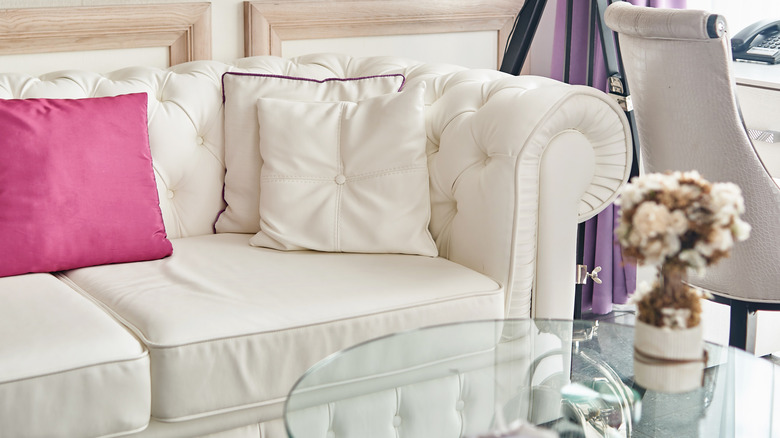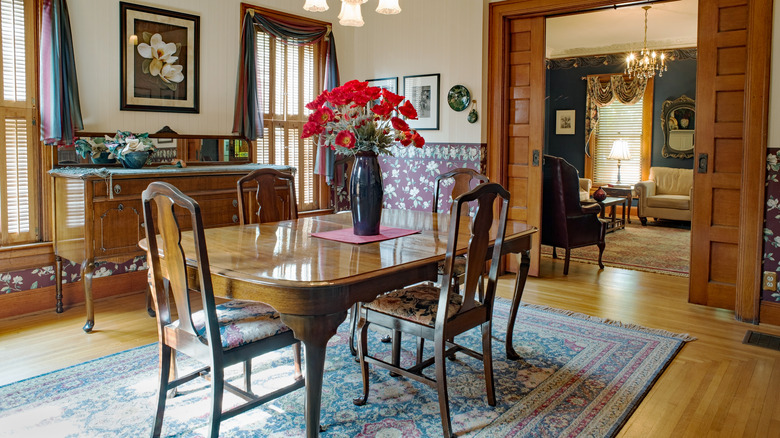5 Classy Ways To Incorporate Little Women Into Your Home Décor
With one book starting it all and several films and series following, Louisa May Alcott's "Little Women" is a heartfelt, coming-of-age story set during the mid-1860s in Concord, Massachusetts. Filled with determined, unforgettable characters, the era in which the story of the March family lives also plays a definitive role. Primarily set at the convivial Orchard House home, the interior design of the Victorian era is wholly represented through dark, rich colors, wood elements, damask wallpaper, transparent curtains, and various ornate fixtures and furnishings.
How do you incorporate these old-world features into your interior design? As often as the classic story has been remade, there are many sophisticated styles to imagine. According to QualityBath, Victorian elegance might embellish large pieces and focal points, including architecture, chandeliers, drapery, fireplaces, stained glass, mirrors, and headboards. More elements like molding, upholstered furniture, flickering candlelight, rugs, wallpaper, and layered window treatments may be seen on the sensual side. From chairs and tables to door trim and wainscotting, there may also be plenty of wooden elements. Everyday life in "Little Women" appears stark yet formal with the subdued papered and painted walls and elegant curtains, including the rugs and furniture. Keep reading to discover more ways to implement their style into your home.
1. Damask wallpaper patterns
Damask wallpaper has been around for centuries, as it adds a refined elegance and ambiance reminiscent of Victorian days. Known for its various ornamental floral designs, the 1994 version of "Little Women" features a neutral-colored wallpaper with a repetitive pattern in the home's foyer. The 2019 version features a similar style within the living room. While many colors of the time may have been more muted, color options are endless these days, per Little Green Paint & Paper. Patterns might include a symmetrical design known as arabesque, which looks significantly striking in black and white or red and gold contrast. Choose from beiges, blues, greens, grays, and gold for a more lowkey appeal. Nature scenes are also an option, which may reflect your location, culture, or family history, like birds, flowers, and trees.
From entryways and family rooms to bathrooms and bedrooms, wallpaper can be used to decorate almost any part of the home. To take absolute precedence, you might cover a large wall to enrich an entire area or focus on an accent wall with your chosen pattern. Installing wainscoting is another way to set your damask wallpaper. Pair it with complementing colors like brown or white and a hardwood herringbone style floor, as seen above.
2. Layered window treatments
A staple of the Victorian era, the ladies of "Little Women" love layers within their drapery. Often used to block out cold air, a full get-up might include a lofty valance or box cornice across the top and a heavy outer layer of curtain that conceals the inner sheer piece, per Homestyle. White or ivory lace curtains are often present throughout the March household, as the pure, translucent material is the lightest part of a drapery ensemble. This soft, delicate material conceals enough to add privacy while letting in the natural light's warmth, as seen within the two bedroom windows pictured above.
Depending on the size of your window, this romantic appearance can be as grand or simple as needed. Sometimes seen with contrasting colors on the fringe, many curtains reflect the age with obscure solid or patterned hues while fully extending to the floor. Made to withstand time, dust, light, and air, the elegant curtains were frequently made from muslin or dimity materials or a blend of the two. You might add a brass rod and rope tiebacks to complete the official look.
3. Detailed wood fixtures
Dress your home with fine wooden fixtures and features. From quaint coffee tables to large dining tables, including chairs, bedframes, and cabinets, wood elements are visible throughout the Orchard House. According to John Canning, many pieces of the time, including wood beams, may have been made of walnut, mahogany, or rosewood, including ash and oak. Commonly seen in rich browns and tans, crown molding and door frames would be constructed of chestnut and pine. You might even fashion a piano like Amy's, typically made of various kinds of wood.
Designed to impress, many tables, chests, and dressers feature ornate detailing along the borders, handles, legs, and feet. For added extravagance, some pieces may showcase intricate designs within the areas of the framework or throughout the body entirely. These antiquated types of pieces can complement an eclectic, modern motif by styling them with a fresh pop of color on the walls, as seen above. Alcove shelving is another example of wood elements within the shelves (also pictured). This shelving can safely store books, candlesticks, keepsakes, and pottery on each side of the March family's fireplace.
4. Elegant, upholstered furnishings
Luxurious yet inviting, many couches and accent chairs of the mid-19th century were characterized by their curvaceous lines, striking colors, plush materials, plump seats, and overall comfort. The period in which the characters of "Little Women" lived may reflect furniture styles from both the Rococo (1840 to 1865) and Renaissance Revivals (1860 to 1890), via Laurel Crown. Graceful and elegant, typical Rococo Revival pieces may celebrate various floral motifs, fruits, and foliage, among other natural elements. Renaissance Revival showcases larger pieces of furniture like the March family's living room couch and chairs seen in the 2019 film version.
A signature appearance for upholstered furniture and headboards also popularized during this time is button tufting. This unique style commonly appears on the backs of or throughout various couches, chairs, and chaises. Mahogany and rosewood were easily manageable to carve and create borders and edges for these furnishings. Generally dressed in lusciously textured materials like velvet, velour, or tapestry, you might update and reupholster an old Victorian-style couch with new color or fabric of your choice. Modern and chic, the image above features a reupholstered tufted couch with a rich white shade that complements the pink and purple elements and a glass or metal table.
5. Rich, decorative textiles
With bitter cold winters and seasonal temperatures, warmth and comfort are always a priority within March's Massachusetts home. Likely covered with hardwood or tile flooring, walking around the house in the winter or spring requires the need for various rugs for numerous spaces. For added warmth and tone, many Victorian-style rugs were Persian and made of natural fibers like corn husks and straw, with classier styles crafted from wool or sheepskin. Antique rugs can easily be found today, as some of the best quality designs may be seen and-or made in India, Pakistan, and Turkey. Here pictured, a decorative blue and red patterned rug rest under the dining table while contrasting the surrounding wood elements.
Decorative tapestries, including cloths, coverings, and wall hangings, are also a great way to incorporate texture. You might use them as a throw or small tablecloth like in Jo's cozy writing loft. If you seek authentic tapestry material, original pieces would typically be hand-dyed and made of wool, cotton, linen, and sometimes silk, per Old & New Shop Inc. Modern materials of lesser value may consist of nylon or polyester. Whether you decorate with rugs or tapestries, you might place neutral colors like beiges or browns in standard rooms, while vibrant reds, yellow, and blues will capitalize in prime entertaining areas.
